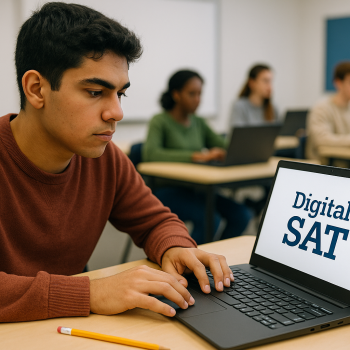Opening the Conversation: Why a Script Helps
Talking about college lists after you get Digital SAT scores can feel like stepping onto a stage with the spotlight on your future. Whether you’re a student who just opened their score report or a parent who wants to be supportive without panicking, a few thoughtful scripts can turn overwhelming conversations into clear, constructive planning sessions.
This article gives you ready-to-use, natural-sounding scripts for different scenarios — celebrating a great score, recalibrating after a disappointment, comparing reach/match/safety schools, and making last-minute decisions. I’ll also weave in practical steps, a sample comparison table, and examples of how personalized tutoring (for instance, Sparkl’s 1-on-1 guidance, tailored study plans, expert tutors, and AI-driven insights) can fit into your plan when it’s helpful.

Before You Start: Ground Rules for a Calm, Productive Talk
Set a tone before you dive into the numbers. Here are five quick ground rules to make the conversation useful and kind:
- Begin with curiosity, not judgment. Ask open questions like “What surprised you?” or “Which parts felt like your best work?”
- Separate score from worth. A test score is information, not an identity.
- Focus on options instead of absolutes. Scores suggest strategy, not fate.
- Prioritize clarity: define terms like “reach,” “match,” and “safety” so everyone’s on the same page.
- Conclude with a next step — even a small one — to turn talk into action.
Understanding the Digital SAT: A Quick Primer
Before using any script, make sure everyone understands what the Digital SAT score report shows and how to interpret it. The Digital SAT has changes from the older paper test: it’s shorter, adaptive by section, and delivers certain universal tools (like a built-in calculator and passage expansion). For planning purposes, focus on:
- Total score and section-level scores (e.g., Evidence-Based Reading & Writing and Math equivalents).
- Percentiles — what the score means relative to other test-takers.
- Subscore or skill-area feedback if available (this helps target study).
Knowing these pieces helps you talk concretely rather than speculating.
Script 1: When the Score Exceeds Expectations — Celebrate and Strategize
Use this script when a student scores higher than they thought — an ideal chance to celebrate, then channel momentum.
Parent: “Wow — this is fantastic. You should be proud of the work you put in. What part felt like it clicked for you?”
Student: “The math felt easier than I expected. Reading was okay.”
Parent: “That’s great to hear. Let’s note this as evidence that your study methods are working in math. Do you want to keep preparing to raise reading, or focus on consolidating strengths? We can look at colleges that become more realistic options now and adjust your list together.”
Why it works: The script validates effort, asks a reflective question, and transitions to a concrete planning step.
Script 2: When the Score Is Lower Than Hoped — Reassure, Review, Replan
A disappointing result doesn’t mean defeat. This script acknowledges disappointment, reframes the outcome, and focuses on next steps.
Parent: “I know you were aiming higher and I’m sorry you’re disappointed. I’m proud of how you handled the whole process so far. Can we look at the report together and see where the biggest gaps are?”
Student: “I thought I would do better on reading.”
Parent: “Okay — let’s see the breakdown and decide if you want a targeted study plan or another test date. We could try some focused practice on those reading question types, or consider tutoring for a few weeks — something that builds confidence without adding pressure.”
Why it works: The script centers empathy, then moves to diagnostic and actionable options, giving the student agency.
Script 3: Comparing Reach, Match, and Safety Schools — A Guided Walkthrough
This is a practical conversation for shaping a balanced college list. Use it after you’ve both reviewed scores and college preferences (size, location, majors, costs).
Parent: “Let’s make three columns: reach, match, and safety. Think of reach as where your current scores are below the typical admitted range, match where they’re in-range, and safety where they’re above — and where you’d still be happy to go.”
Student: “How many of each should we pick?”
Parent: “A common approach is 2–4 reaches, 3–5 matches, and 1–3 safeties. We’ll also check fit and finances, not just scores. Want to list the schools you’re dreaming about and we’ll place them together?”
Why it works: The script provides a simple framework and an inclusive planning method, so decisions aren’t driven purely by anxiety.
Script 4: The “If-Then” Conversation — Planning Multiple Paths
“If-then” scripts reduce all-or-nothing thinking by giving parallel plans.
Parent: “If you raise your composite score by 40 points, then we’ll prioritize schools A and B. If not, then we’ll emphasize some of your matches and safeties and focus on strong essays and extracurricular highlights.”
Student: “That makes things feel less scary.”
Parent: “Exactly — we’ll keep options open. Want to build a small timeline with test dates and essay drafts so we don’t scramble later?”
Why it works: Concrete contingencies reduce uncertainty and distribute the workload into manageable steps.
Script 5: Talking About Test-Optional Policies and Context
Many colleges have flexible testing policies. You’ll want to mention how scores fit into a broader application profile.
Parent: “Some colleges won’t require SAT scores or treat them as optional. That doesn’t mean scores don’t matter — they’re one part of your story. If your score strengthens your application, include it; if not, we’ll focus on essays, recommendations, and activities.”
Student: “So we can choose where to send scores?”
Parent: “Yes. We’ll pick schools where your application is strongest whether or not the score is included. We can also ask an advisor or counselor to help decide which schools should see test results.”
Why it works: This script clarifies that testing is one component and that strategic choice — not fear — drives score submission.
How to Use Data Visuals to Make Decisions
Numbers can feel abstract. A simple table comparing a few colleges against your score helps make decisions tangible. Here’s a sample layout you can adapt.
| College | Typical SAT Range (Middle 50%) | Category (Reach/Match/Safety) | Other Fit Notes |
|---|---|---|---|
| College A | 1280–1440 | Reach | Strong programs in environmental science; high merit aid for strong essays |
| College B | 1150–1300 | Match | Good internships nearby; smaller class sizes |
| College C | 980–1150 | Safety | Generous transfer pathway and strong student support |
Use your own score and the colleges you’re considering — this table turns abstract ranges into actionable categories.
Script 6: Financial Reality Check — Sensitive but Necessary
Money often determines whether a school is realistic. Approach this gently but honestly.
Parent: “I want us to include schools that excite you, but we also need to think about cost and aid. Let’s mark each college with estimated net price ranges and whether merit scholarships apply. If your score improves, some colleges may offer more merit aid. Want to look at this together and see where we might stretch and where we should be practical?”
Student: “I don’t want to waste time on schools that are impossible to afford.”
Parent: “Me neither. We’ll include a couple of dream options and several practical ones, and follow up with net price calculators and financial aid conversations.”
Why it works: The script frames economics as a planning variable rather than a punishment.
Putting Tutoring Into the Script: Where Sparkl Fits Naturally
Sometimes an outside tutor helps translate score reports into focused progress. You might say:
Parent: “If you want targeted help on a couple of sections, we could try short, personalized tutoring—like Sparkl’s 1-on-1 sessions that give tailored study plans and AI-driven insights—just to see if focused coaching helps before we commit to another test date.”
Student: “That sounds less overwhelming than a long class.”
This keeps the option practical, time-limited, and centered on the student’s choices.
Sample Timeline: From Score to Application
Having a timeline reduces last-minute stress. Here’s a sample 12-week roadmap after receiving a Digital SAT score that needs improvement but can still be raised:
- Week 1: Review score report with a counselor/parent and identify top 2–3 skill gaps.
- Weeks 2–5: Focused study using practice sections; consider 4–6 weekly hours of targeted practice or short 1-on-1 tutoring sessions.
- Week 6: Take a full-length practice test under test-like conditions to measure progress.
- Weeks 7–9: Refine weak areas; start or continue essays and gather recommendations.
- Week 10: Final practice test; decide whether to register for a test date or rely on application strengths without an additional score.
- Weeks 11–12: Finalize college list, confirm financial planning, and polish applications.
Real-World Example: Two Siblings, Two Strategies
Concrete stories help make scripts feel relatable. Consider two siblings: Maya and Jordan.
Maya scored above her target in math but just below in reading. Using a calm script, her family celebrated the math win and enrolled her in a short, targeted reading program focused on passage analysis. Two months later, she raised her reading subscore by 30 points and felt more confident sending her improved score to match schools.
Jordan’s first score was lower than expected. Instead of pushing immediate retakes, his family used the “if-then” script: if he could raise his score by 50 points in three months, they’d apply to his top-choice reach; if not, they’d invest more in essays and extracurricular leadership for match schools. He chose to focus on activities and essays, ultimately receiving a strong financial aid package from a match school where he thrived.
These stories show there isn’t one right path — there are thoughtfully chosen ones.
Language Tips: Tone, Phrasing, and Pointers
Small changes in wording can make a big difference. Here are language tips to keep conversations supportive and strategic:
- Use “we” instead of “you” to create teamwork: “Let’s look at this together.” instead of “You need to redo this.”
- Avoid absolute words like “fail” or “ruined.” Replace them with “setback” or “opportunity to improve.”
- Ask two questions for every directive: one to understand, one to guide action.
- Let silence be part of the process — give the student time to reflect before responding.
When to Involve Counselors and Tutors
Not every score needs intervention, but consider professional help if:
- The student is consistently anxious about testing and it’s affecting daily life.
- Score report shows repeatable, targetable weaknesses (e.g., specific problem types).
- There’s a narrow application timeline and efficient, expert help could improve outcomes.
Personalized tutoring—like Sparkl’s model of tailored study plans and expert tutors combined with AI-driven diagnostic insights—can be a highly efficient way to address specific gaps in a short time. Use it if it fits the student’s learning style and timeline.
Final Script: A Short, Heartfelt Wrap-Up
After all the planning, end each conversation with warmth and clarity. Try this concise, supportive wrap-up:
Parent: “Thanks for going through this with me — I know it’s a lot. We have options, and we’ll take the next step together. Which of the small next steps do you want to own this week?”
That question invites ownership and keeps the momentum going without overwhelming anyone.

Closing Thoughts: Scores Are Guides, Not Gatekeepers
Digital SAT scores are powerful pieces of information — but they don’t tell the whole story. When you move from panic to practical scripts, you give the student hope, context, and a plan. Whether you celebrate, retool, or pivot, the most important ingredients are empathy, clarity, and a willingness to make data-driven decisions together.
And remember: short, personalized interventions (like focused 1-on-1 tutoring, tailored study plans, and targeted diagnostics) often move the needle faster and with less stress than marathon courses. Keep conversations compassionate and action-oriented, and you’ll turn a score report into a roadmap for opportunity.
Quick Checklist: After You Read the Score
- Take a deep breath — don’t decide in the first hour.
- Review section breakdowns and percentiles together.
- Classify schools into reach/match/safety using a simple table.
- Decide on one small next step (practice test, tutoring session, essay draft).
- Set a follow-up date to review progress and adjust the plan.
Want Help Building a Plan?
If you’d like a short, personalized plan to turn current results into the strongest possible application, consider a focused tutoring approach — even a trial of one or two sessions can clarify whether targeted coaching will help. Many families find that a blend of strategic conversations, honest financial planning, and short-term, expert tutoring creates the clearest, calmest path forward.
Good luck — and remember, the conversation you have after a score matters as much as the score itself. Use these scripts to make that conversation steady, informed, and hopeful.














No Comments
Leave a comment Cancel